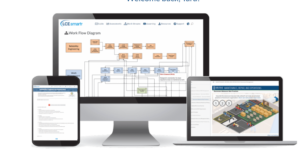The Swagelok Reliability Journey Includes an Important Role for Reliability Engineers
Introduction
Swagelok Company, founded in 1947 in Cleveland, Ohio, U.S.A., began with a single product – the Swagelok® tube fitting. The company has grown into a global corporation that designs, develops, and manufactures thousands of types of high-quality, general-purpose and specialty fluid system products and services to meet the evolving needs of global industries.
Swagelok products are designed to meet exacting requirements in industrial processes ranging from research, instrumentation, pharmaceutical, dairy, and food and beverage production, to automotive (NGV and fuel cells), oil and gas, pulp and paper, power generation, petrochemical processing, ship building, and semiconductor manufacturing.
Today, Swagelok Company is a $1.3 billion privately held company with a responsive, capable supply chain that drives solutions and delivers value to customers worldwide through an exclusive network of more than 200 authorized sales and service representatives on six continents. It employs approximately 4,000 associates worldwide.
Manufacturing operations take place in a lean environment, with more than 1000 different work centers handling machining, processing, and assembly of products. The company began implementing lean manufacturing practices, which led to cost reductions and fewer touchpoints, but did not improve overall equipment effectiveness (OEE). The company was facing higher-than-desired machine downtime. Swagelok started a benchmarking project to research different types of approaches to improve its maintenance program.
Swagelok identified Reliability Excellence as a strategic improvement initiative and partnered with Life Cycle Engineering (LCE). The company felt that LCE’s methods and best practices would be the best fit with Swagelok’s culture and lean journey. A site assessment identified that Swagelok was functioning under reactive maintenance schedules, and design work began quickly after for new maintenance business processes.
Progress
LCE and Swagelok worked together to design new maintenance business processes, which resulted in three individual workflows:
- Materials Management
- Work Management
- Reliability Engineering
Teams for each were put together by selecting associates from various operations groups and assigning them to the appropriate team based on their experience. An independent Integration Team was also formed to focus on integrating these business processes into Swagelok’s current programs and culture.
Implementation
An overall Project Implementation Team, which included members of the business process design teams to ensure continuity, led implementation. The team members ensured that Swagelok had a good understanding of both the present-state (pre Reliability Excellence) and future-state business processes.
The plan was to conduct an individual implementation at each company site. Project deliverables included:
- All site associates had to be trained in new business processes; and
- Associates had to implement new processes in their daily line of business.
Progress was to be measured by auditing a large sample of the groups.
During implementation, the Integration Team supported the change management and communication functions at each site. The movement from a highly reactive maintenance organization to the end goal—a proactive approach—was a culture shift for Swagelok. While the company had tried to implement work-order based approaches before, success was short lived. The Integration Team was crucial in making sure all business processes were followed, without exception.
Outcomes
A few months into the implementation process, Swagelok realized that it needed a centralized maintenance organization to ensure the alignment and collaboration necessary for success. The resulting maintenance group is centrally managed within the Swagelok operations group and reports to a director level. It enabled the company to improve resource use and better control MRO spending. Additionally, implementation project managers reported up through the same chain, resulting in better communication and prioritization between the project implementation team and the line of business groups who were receiving the new business processes.
Progress audits from the implementation phase revealed several opportunities for further improvement at Swagelok, including:
- The maintenance functions, including Planners and Reliability Engineers (REs), reported to production at each site that they worked in,
- Prior staffing models assigned certain techs to the same equipment, making the company very efficient in reacting to emergencies,
- Materials management relied on one person at each site who had single site visibility and access,
- The inventory management philosophy was simply to never run out of anything,
- Downtime information from OEE measurements and repair information from CMMS software were not being analyzed to help determine driving factors for downtime and cost; and
- A small number of machines had excessive downtime and were using excessive amounts of spare parts — complex machines termed “bad actors” by Swagelok
To address the issue of the “bad actors,” or the small group of machines at each site that negatively impacted maintenance schedules, Swagelok reliability engineers employed a disciplined problem solving process to determine the root cause of the problem. The reliability approach resulted in:
- Reduced MRO spend,
- Large reductions in unplanned downtime,
- Improved maintenance plans for equipment upgrades; and
- Standardization of predictive approaches.
In addition to overall business process implementation, Swagelok discovered several individual opportunities for Reliability Engineering.
Conclusions
While the implementation of Reliability Excellence is ongoing at Swagelok, the company has laid the foundation to achieve its desired goal of 80 percent planned work. Implementing new business processes increased efficiency, but the true value came from reliability engineering, which reduced failures. The reduction in MRO spend itself covered the cost of the project at Swagelok and resulted in strong support from senior management to move forward.
Life Cycle Engineering, Inc
For More Information
843.744.7110 | info@LCE.com
















